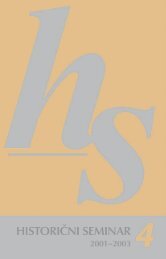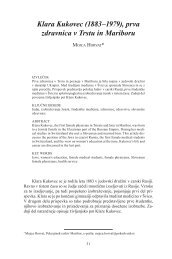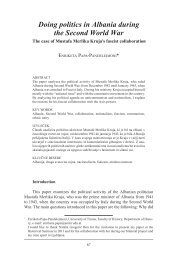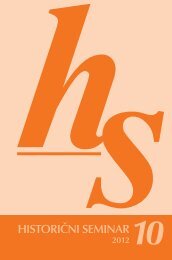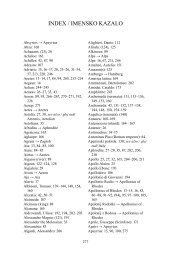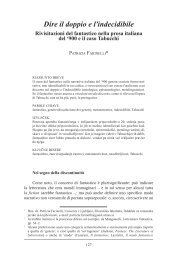The Invention of Modern Aesthetics: From Leibniz to Kant
The Invention of Modern Aesthetics: From Leibniz to Kant
The Invention of Modern Aesthetics: From Leibniz to Kant
You also want an ePaper? Increase the reach of your titles
YUMPU automatically turns print PDFs into web optimized ePapers that Google loves.
<strong>The</strong> <strong>Invention</strong> <strong>of</strong> <strong>Modern</strong> <strong>Aesthetics</strong>: <strong>From</strong> <strong>Leibniz</strong> <strong>to</strong> <strong>Kant</strong><br />
ambiguous, for his programme for aesthetics has been taken over only<br />
in part by later philosophers and theorists. <strong>Aesthetics</strong>, in Baumgarten’s<br />
deinition, is not only the science <strong>of</strong> sensible knowledge, but also the<br />
theory <strong>of</strong> the liberal arts, the doctrine <strong>of</strong> inferior knowledge, the art <strong>of</strong><br />
beautiful thought and the art <strong>of</strong> the analogue <strong>of</strong> reason. 78 <strong>Aesthetics</strong><br />
has, <strong>of</strong> course, mostly been conceived <strong>of</strong> as the philosophy <strong>of</strong> art, or, as<br />
the theory <strong>of</strong> the arts, whereas Baumgarten’s idea <strong>of</strong> aesthetics as the<br />
theory <strong>of</strong> sensuous knowledge has been all but ignored, moreover, he<br />
did not develop a complete philosophy <strong>of</strong> art or a complete theory <strong>of</strong><br />
art comprising all the art forms. 79<br />
With <strong>Kant</strong> and his third critique, Kritik der Urteilskraft (1790),<br />
we enter another world, and an entirely new phase in the development<br />
<strong>of</strong> »aesthetic« thought and analysis. <strong>Kant</strong>’s use <strong>of</strong> the term »aesthetics«,<br />
however, is complicated, it is certainly not synonymous with<br />
»philosophy <strong>of</strong> art« and is thus very different from, for example,<br />
Schelling’s and Hegel’s conceptions. In the irst part <strong>of</strong> the »Transzendentale<br />
Elementarlehre«, the »transcendental aesthetics«, <strong>of</strong> the<br />
Kritik der reinen Vernunft (1787), »aesthetics« means »sensible« and<br />
»that which pertains <strong>to</strong> the senses«. <strong>The</strong> transcendental aesthetics is<br />
concerned with the analysis <strong>of</strong> the preconditions <strong>of</strong> sensuous experience,<br />
and has nothing <strong>to</strong> do with aesthetics in Baumgarten’s sense nor<br />
with art and aesthetic experience. 80 <strong>Kant</strong> explicitly rejects »aesthetics«<br />
as a synonym for »the critique <strong>of</strong> taste«, since aesthetics is the fallacious<br />
attempt <strong>to</strong> bring »the critical assessment <strong>of</strong> beauty under rational<br />
principles, and <strong>to</strong> elevate the principles <strong>of</strong> beauty in<strong>to</strong> a science«, 81<br />
and Baumgarten, »the excellent analyst«, is singled out as harbouring<br />
this illusion. 82 In the Kritik der Urteilskraft, <strong>Kant</strong>’s aim is <strong>to</strong> provide a<br />
critique, i.e. an analysis <strong>of</strong> the conditions for the possibility <strong>of</strong> aesthetic<br />
and teleological judgments. <strong>The</strong> work is thus divided in<strong>to</strong> two major<br />
78<br />
»AESTHETICA (theoria liberalium artium, gnoseologia inferior, ars pulchre<br />
cogitandi, ars analogi rationis) est scientia cognitionis sensitivae«, Baumgarten,<br />
Aesthetica, § 1, in Baumgarten, <strong>The</strong>oretische Ästhetik, p. 2.<br />
79<br />
Baumgarten was criticized for privileging poetry and rhe<strong>to</strong>ric in his »aesthetics«; in<br />
his encyclopaedic work, Allgemeine <strong>The</strong>orie der schönen Wissenschaften und Künste<br />
(1771–1774), Johann Georg Sulzer complains that Baumgarten, because <strong>of</strong> his »limited<br />
knowledge <strong>of</strong> the arts did not by far describe all the expressions <strong>of</strong> beauty«, aesthetics<br />
is in his opinion »still an underdeveloped philosophical science« (quoted from<br />
the article »Ästhetik/ästhetisch« in Ästhetische Grundbegriffe, p. 332, my transl.).<br />
80<br />
»Eine Wissenschaft von allen Prinzipien der Sinnlichkeit a priori nenne ich die<br />
transzendentale Ästhetik«, <strong>Kant</strong> declares (Immanuel <strong>Kant</strong>, Kritik der reinen Vernunft,<br />
1787, Hrsg. Karl Vorländer, Hamburg: Felix Meiner, 1956, p. 64).<br />
81<br />
Ibid., p. 65, my transl. <strong>The</strong> German original reads: »… die kritische Beurteilung des<br />
Schönen unter Vernunfprinzipien zu bringen, und die Regeln derselben zur Wissenschaft<br />
zu erheben«.<br />
82<br />
Ibid.<br />
151



